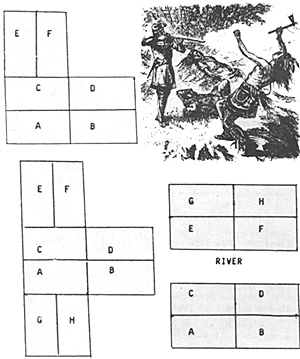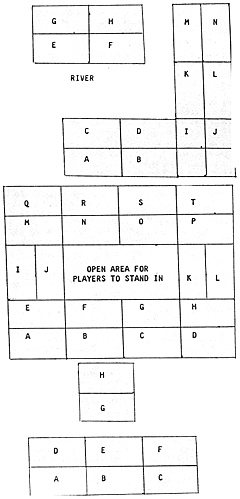 The size of our wargames table determines a great deal in our wargames. Two standard 3' X 8' tables joined together represent an area of 1440 X 1920 yards utilizing a ground scale of 1" = 20 yards. This provides a length of just over a mile and a width just under a mile, an area usually too small to conduct large battles. There exist three alternatives, all of them quite viable to one degree or another although each possesses shortcomings.
The size of our wargames table determines a great deal in our wargames. Two standard 3' X 8' tables joined together represent an area of 1440 X 1920 yards utilizing a ground scale of 1" = 20 yards. This provides a length of just over a mile and a width just under a mile, an area usually too small to conduct large battles. There exist three alternatives, all of them quite viable to one degree or another although each possesses shortcomings.
First, one can utilize different sized wargames figures and then change to ground scale accordingly. A 6' X 8' table with 5mm figures using a ground scale of 1" equals 100 yards begins to resemble a country at 7200 X 9600 yards or 4 X 9' miles and will allow virtually any major battle to be fought. Even in 15mm with a ground scale of 1" = 50 yards, one still has a reasonably large table surface with 3600 X 4800 yards or 2 X 2.7 miles. However, if one has 25mm or 30mm figures, quite possibly the most common sized troops, 25mm that is, we have a problem as our table is back to .8 X 1.1 miles. One can always increase the ground scale, the second alternative, while still utilizing 25mm/30mm figures although this results in a fair amount of ground misrepresentation/distortion and is not, for that reason, always an adequate solution.
This leads us to the third alternative and the subject of this article, adding tables. Table length becomes a problem only when one is limited by a small room or by the unavailability of additional tables, thus adding tables to increase the length will not be further discussed due to the fact that it is an obvious solution. However, even if two additional tables are added resulting in a 6' X 16' surface, or .8 X 2.2 miles (at 1" = 20 yards), what we have is a generally adequate length and an inadequate width as this solution provides only for two armies facing each other along a wide front, our usual wargames encounter.
The width of our playing surface is perhaps the most difficult issue to solve. Everyone would like to have a longer table width, however, it is limited by our reach. Having played in games conducted on the floor makes my 39 year old knees behave far beyond their chronological age and although I have participated in a number of floor games and have never seen figures stepped en, I.-,am always sure it will happen. I am told that a huge playing surface was used at Origins 85 by joining lots of tables together, however, the picture in HMGS's last insert in MWAN of a gamer laying on the table to move troops located in the center sends shivers down my spine.
What then are the other options? Provided one has sufficient room and tables, one can arrive at a plausible, though not perfect solution. For my Isandhlwana game I was confronted by the very problem discussed thus far. I was able to solve the length problem by adding tables to create a twelve foot length, adequate for the size of the battle, but if I stayed with a six foot width, the Zulus had to be placed on the table right in front of the British perimeter, s situation unacceptable to me. This was solved by reviewing the terrain area required for the battle. When I examined the important battle area, I realized that it resembled an L shape. The Zulus entered off the plateau situation along the left side of the table and fanned out along the front, flanks and left rear of the camp. Thus, I added two 3' X 6' tables length-wise along the left front of my existing four 3' X 6' tables rendering a playing surface as such:
Utilizing such a method I was able to represent every bit of Isandhlwana required for the battle; 3,200 25mm figures were placed on the table without being stand to stand; the flanks and the rear of the camp were reachable by the Zulus; and nearly every inch of table space, with the exception of small areas on tables C and A could easily be reached with a minimum of difficulty and little danger to the figures. The possibilities inherent in in such a system hardly stand to revolutionize the hobby although they radically increase the variety of games which can be planned. One could, for example, add tables G and H to lower edge of A table and create a situation where a defending army could be on tables C and A, Facing D and B, and the attacking army could enter on tables 0 and B and possibily F and/or H to threaten the flanks.
The defending army could be stopped, by game conditions, from protecting their flanks until the threat to the flanks was apparent. If a game host really wishes to endanger his own physical/mental state, he could start the game minus tables E, f,-g, and H, and add them when the attacking force and/or outflanking force(s) enter the game. Why is it that I love designing such games yet hate playing in them? No, actually, a game host should never utilize such an approach without at least hinting at the possibility of such an event. See illustration to the left below:
 There are other possibilities available to us. Suppose you devise a scenario with a river. Set up your tables in six feet widths with enough of a separation so as to allow player movement between then as is illustrated below to your right:
There are other possibilities available to us. Suppose you devise a scenario with a river. Set up your tables in six feet widths with enough of a separation so as to allow player movement between then as is illustrated below to your right:
Provided one had sufficient tables availabe, one could also add tables and change their location so as to represent the changing path of the river, although this method limits the river's flow to right angles as such:
It would also be possible to use a table configuration such as in the last two illustrations and ask players to imagine that the open areas are actually joined. Thus, if a unit on table C on the illustration on the lower right hand side of page 33 wish to fire a unit on table E and both were three inches from the edge of each table facing the space between them, the range would naturally be six inches.
There may be some battles in which a terrain feature, such as a town, swamp, impassable hill, extremely heavy woods, small lace, etc., can be used to our advantage as such shown below:
I hope to, in the future, conduct games utilizing such approaches, beyond my Isandhlwana game, and report on them within the pages of MMAN. For example, when my Sudan porject is completed, I intend to devise a scenario in which a fort, supported by shore batteries, island batteries, and troops outside the fort, is attacked by a British/Allied force including gunboats. Such a setup could conceivably be arranged as is brilliantly illustrated below:
The fort would be placed on table E near the area facing G; tables G and H would represent the island; shore batteries could be located on tables G and F facing the island; the British and Allied force would enter on table B or B and C or A, while the Dervish forces outside the fort would be on D and F as well as, for example, table A. Some of the Dervish units would be hidden in gullies, a common Dervish tactic, end as such, would not be represented on the table until located, when they attacked. The gunboats would be placed on bar stool-type chairs with the entire chair being moved as the gunboat makes it's way up and down the river. I welcome any additional ideas such as those presented in this article.
Back to MWAN # 20 Table of Contents
Back to MWAN List of Issues
Back to MagWeb Magazine List
© Copyright 1986 Hal Thinglum
This article appears in MagWeb.com (Magazine Web) on the Internet World Wide Web.
Other articles from military history and related magazines are available at http://www.magweb.com